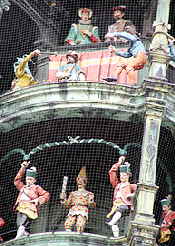Munich and Salzburg – Two irresistible cities to visit!
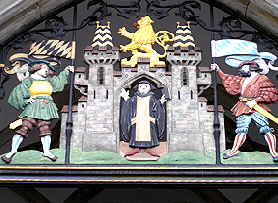 Munich, or München, as it is known in German, is the third largest city in Germany after Berlin and Hamburg, and is in the heart of Bavaria. It is conveniently located and is only 1-hour by plane from Berlin, Frankfurt, and Prague, and is easily accessible by train. As an added bonus, on a clear day, you can see the Bavarian Alps.
Munich, or München, as it is known in German, is the third largest city in Germany after Berlin and Hamburg, and is in the heart of Bavaria. It is conveniently located and is only 1-hour by plane from Berlin, Frankfurt, and Prague, and is easily accessible by train. As an added bonus, on a clear day, you can see the Bavarian Alps.
Edward F. Nesta and I flew into the Munich airport in March 2005, where Mr. Dennis Moser, of the Kempinski Hotel Vier Jahreszeiten Munich, met us. Sitting in the back of the hotel’s BMW limousine, (which wasn’t too much of a surprise as BMW has its headquarters in Munich), we enjoyed our first glimpses of Munich, wearing its winter white coat of snow, even though it was March. We arrived at the legendary Kempinski Hotel Vier Jahreszeiten Munich, Maximilianstrasse 17, which was built in 1858, and is a grande dame among grande dames. I fell in love with the hotel the minute I entered the lobby with its beautiful stained-glass dome depicting the Four Seasons, which reminded me of another grande dame hotel, the Hotel Hermitage in Monte Carlo, which also has an ornate stained-glass ceiling. After a warm welcome to the hotel by Mr. Malte Wiedermeyer, Director of Business Development, Ms. Malwine Berthold, Guest Relations Manger, whisked us effortlessly to our beautiful suite of rooms. Read about the hotel in our Hotels & Resorts section.
The hotel is perfectly located on the prestigious Maximilianstrasse, where it is surrounded by luxury world-class designer boutiques. Once I was able to take my eyes off the shopping, Edward and I did get to explore the city. Although there are several bierhalles and biergartens in Munich, we never set foot in any of them! We did however thoroughly enjoy finding our own “discoveries” in this beautiful city. We went to the square Marienplatz and watched the famous glockenspiel with its bells and its charming moving figures located on the Gothic Altes Rathaus (Old City Hall), which performs at various times throughout the day depending on the season, and to the Theatinerkirche, an Italian baroque design church that is startling all white inside. It was a cold March day, much colder than we had anticipated, with snow crunching underfoot, so we decided to spend a few hours in a museum to warm up, as well as partake of the cultural aspects of Munich. We went to the Kunstalle Der Hypo-Kulturstiftung, Theatinerstraße 8, to see the Toulouse-Lautrec exhibit of his posters, lithographs, pre-prints, and trial copies, which was an extensive collection of his work from his brief life, 1864-1901. Henri Toulouse-Lautrec was inspired by the new technology, and he in turn inspired modern poster art.
In the evening, we had the great pleasure of dining at Restaurant Tantris, a 2-star Michelin restaurant that deserves a trip to Munich just to experience the culinary genius of Chef Hans Haas. To make sure that we weren’t disappointed in not being able to reserve a table, we made our reservation before we left home! Please read the article on our gastronomic odyssey of a dinner at Restaurant Tantris in our Restaurants section and read Chefs' Recipes where Chef Haas generously shares his recipes for a delectable four-course dinner that you will want to try recreating at home.
We returned to the Kempinski Hotel Vier Jahreszeiten Munich and found that even though it was quite late, the English piano bar was still busy, so we found a table and decided to have a nightcap and enjoy the music before calling it an evening.
The next day, we had a delicious breakfast at the BistroRestaurant at the hotel, where the sumptuous breakfast buffet has something for everyone, including homemade pretzels. Whenever I am in Germany, I always sample a pretzel or two, and I have to say that these were excellent.  Once again, we explored the altstadt, or old city, and stopped now and again to look at the Easter decorations in the shop windows. Near the hotel there are several chocolate shops that tempted passersby with their incredible window displays of fantasy chocolate creations that must have figured prominently in the sweet dreams of many people.
Once again, we explored the altstadt, or old city, and stopped now and again to look at the Easter decorations in the shop windows. Near the hotel there are several chocolate shops that tempted passersby with their incredible window displays of fantasy chocolate creations that must have figured prominently in the sweet dreams of many people.
We stopped in Alois Dallmayr, located at KF- Dienerstraße 14-15, which is a “must stop” for gourmands and foodies. This gorgeous shop reminded us of a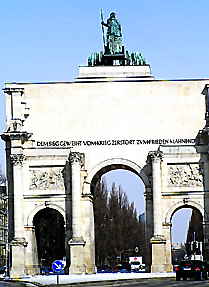 smaller version of the food hall at Harrods’s in London. Suffice to say, it carries everything from live lobsters cavorting in the fountain in the middle of the shop, to caviar, fresh seafood, an assortment of canapés, exotic fruits and vegetables, and every condiment that you could think of, plus chocolates, teas and decadent pastries. For those that cannot wait until they return home, they also have a restaurant where you can sample their tasty menu.
smaller version of the food hall at Harrods’s in London. Suffice to say, it carries everything from live lobsters cavorting in the fountain in the middle of the shop, to caviar, fresh seafood, an assortment of canapés, exotic fruits and vegetables, and every condiment that you could think of, plus chocolates, teas and decadent pastries. For those that cannot wait until they return home, they also have a restaurant where you can sample their tasty menu.
Since no trip for Edward would be complete without purchasing new music for his Music Scene column, we made a stop to Saturn Electro where he listened to and purchased many new cds based on recommendations that he received from Dennis Moser of the Kempinski Hotel Vier Jahreszeiten Munich. We also made at a stop at Rosenthal, where I purchased egg shaped candles that when lit expose their yellow “yolk” with a white exterior “shell”, that I thought that my young nephews, Steven and Thomas would enjoy at Easter.
We returned to the hotel and had a wonderful two-course Bavarian lunch at the hotel’s BistroRestaurant with Ms. Corinna Optekamp, who works in Public Relations. Read about our lunch in the Restaurants section, as well as in Chefs' Recipes, where Chef Michael Rieg shares his recipes for an appealing four-course Bavarian dinner.
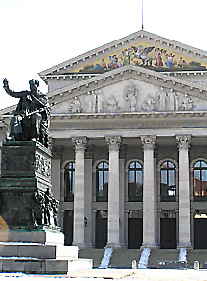 In the evening, we were ready to explore the nightlife, and although the Bavarian State Opera on Maximilianstrasse did have tickets available, we decided that although opera is wonderful, what we really we wanted to do was to go and listen to jazz. After some research and consultation with the Concierge, we decided to go to Jazzclub Unterfahrt, Einsteinstraße 42/44, which is probably the best-known jazz club in the city. Since we had eaten a late lunch, we decided to bypass dinner and take our chance with snacks at the club. Their menu is limited, but it served the purpose, as we were more interested in satisfying our music hunger. We had the good fortune of being there the night that the Latin jazz group, Buena Vida, was performing at the club, whose genre is Latin and Tango music, and is an eclectic mix of international musicians – Fabio Block and Borel de Souse from Brazil, Mundo Burgos from Argentina, and Manolo Diaz from Malaga, although all of the band members now live in Munich. If there was any doubt as to whether or not Latin jazz is thriving in Munich, this group provided the proof that it certainly is, as they played to a packed audience. Whether they played the classic standard Besa me mucho or their own Te quiero un corazon, the audience moved in their seats to the Latin rhythms until finally, despite the lack of a dance floor, several couples did get up and danced in the narrow spaces between the tables.
In the evening, we were ready to explore the nightlife, and although the Bavarian State Opera on Maximilianstrasse did have tickets available, we decided that although opera is wonderful, what we really we wanted to do was to go and listen to jazz. After some research and consultation with the Concierge, we decided to go to Jazzclub Unterfahrt, Einsteinstraße 42/44, which is probably the best-known jazz club in the city. Since we had eaten a late lunch, we decided to bypass dinner and take our chance with snacks at the club. Their menu is limited, but it served the purpose, as we were more interested in satisfying our music hunger. We had the good fortune of being there the night that the Latin jazz group, Buena Vida, was performing at the club, whose genre is Latin and Tango music, and is an eclectic mix of international musicians – Fabio Block and Borel de Souse from Brazil, Mundo Burgos from Argentina, and Manolo Diaz from Malaga, although all of the band members now live in Munich. If there was any doubt as to whether or not Latin jazz is thriving in Munich, this group provided the proof that it certainly is, as they played to a packed audience. Whether they played the classic standard Besa me mucho or their own Te quiero un corazon, the audience moved in their seats to the Latin rhythms until finally, despite the lack of a dance floor, several couples did get up and danced in the narrow spaces between the tables.
After spending two days exploring the city of Munich, we wanted to venture out and explore other areas, and while visiting the castles offered an interesting venue, driving 2 hours by car over snowy mountain roads didn’t quite appeal to us. Also, since we only had packed thin leather shoes and light coats with us, we certainly did not have the right clothes to visit the mountains.  We decided instead to take a train to Salzburg, Austria since it is only a 1½-hour train ride from Munich, and we could take a 9:00 am train and return later that same day. There is a Lufthansa City Center and travel agency conveniently connected to the Kempinski Hotel Vier Jahreszeiten Munich, which allowed us to purchase the tickets the same morning just before our trip, and then take a short taxi ride from the hotel to the train station. The train trip to Salzburg was breathtaking as we passed the magnificent Bavarian Alps, past snow-laden pine trees that looked like nature’s skyscrapers, and past pristine white landscapes unmarred by a single footstep, that I kept my face turned to the window watching the passing scenery, much like a child who was seeing snow for the first time.
We decided instead to take a train to Salzburg, Austria since it is only a 1½-hour train ride from Munich, and we could take a 9:00 am train and return later that same day. There is a Lufthansa City Center and travel agency conveniently connected to the Kempinski Hotel Vier Jahreszeiten Munich, which allowed us to purchase the tickets the same morning just before our trip, and then take a short taxi ride from the hotel to the train station. The train trip to Salzburg was breathtaking as we passed the magnificent Bavarian Alps, past snow-laden pine trees that looked like nature’s skyscrapers, and past pristine white landscapes unmarred by a single footstep, that I kept my face turned to the window watching the passing scenery, much like a child who was seeing snow for the first time.
Once in Salzburg, we found that our leather shoes and thin coats, which we had worn, thinking that spring had arrived in Europe when we had packed our clothing for the trip, were no match for the very cold weather that we encountered in Salzburg. 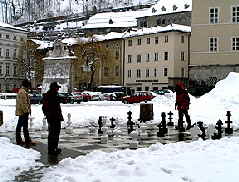 However, hearty souls that we are, and with limited time in Salzburg to spend, we decided to forego using our few precious hours in Salzburg shoe shopping, and instead braved walking through the snow, and stopped in shops along the way to thaw out a bit before continuing on our exploration of the city. Along the way, we came across the Salzburg Tourism Office, Auerspergstraße 6, where we had the great fortune of arriving just when a City Walking Tour was about to start. The 1-hour City Tours are offered everyday at 12:15 pm, are presented in English and German, and cost 8 Euros per person. Our small tour group consisted of Dr. and Mrs. Spengler, an amiable couple visiting from Wiesbaden, Germany, Edward and I, and our Guide, Horst Reischenböck, who was a veritable treasure trove of information. We learned that Salzburg is 2,005 years old, and has a natural fortification: the river and the hill. It is the 4th largest city in Austria,
However, hearty souls that we are, and with limited time in Salzburg to spend, we decided to forego using our few precious hours in Salzburg shoe shopping, and instead braved walking through the snow, and stopped in shops along the way to thaw out a bit before continuing on our exploration of the city. Along the way, we came across the Salzburg Tourism Office, Auerspergstraße 6, where we had the great fortune of arriving just when a City Walking Tour was about to start. The 1-hour City Tours are offered everyday at 12:15 pm, are presented in English and German, and cost 8 Euros per person. Our small tour group consisted of Dr. and Mrs. Spengler, an amiable couple visiting from Wiesbaden, Germany, Edward and I, and our Guide, Horst Reischenböck, who was a veritable treasure trove of information. We learned that Salzburg is 2,005 years old, and has a natural fortification: the river and the hill. It is the 4th largest city in Austria, 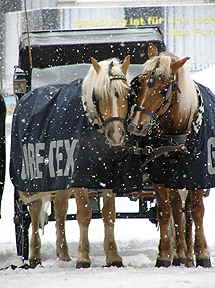 and only became a part of Austria in 1816. Although Salzburg once had many salt mines, they are no longer active, but are now kept open as museums, although during our short stay we did not have enough time to visit them. This charming city has been a cultural center since 925 AD when they started the Music Festival, which is the 3rd oldest Music Festival in the world, after Vienna and Verona, Italy. The snow was falling as we walked through this quaint city, creating the effect of walking in a fairytale, as I diligently tried to take notes as the large snowflakes landed on my eyelashes and melted on my notebook
and only became a part of Austria in 1816. Although Salzburg once had many salt mines, they are no longer active, but are now kept open as museums, although during our short stay we did not have enough time to visit them. This charming city has been a cultural center since 925 AD when they started the Music Festival, which is the 3rd oldest Music Festival in the world, after Vienna and Verona, Italy. The snow was falling as we walked through this quaint city, creating the effect of walking in a fairytale, as I diligently tried to take notes as the large snowflakes landed on my eyelashes and melted on my notebook
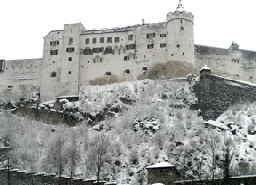 We stopped to admire the Hohensalzburg Fortress, and the funicular, where visitors can ride to the top instead of climbing the steep hill, as well as at the Cathedral, called the “Dom”, which is the earliest Italian church in the Alps. It has 5 independent fixed organs, and is the only known church to have 5 organs. I could only imagine how magnificent it must sound with all of the organs playing in unison. Outside, we walked through the Cemetery, which is over 1,300 years old and is the oldest known cemetery that is still in use today, and past the Catacombs, which were hewn out of rocks.
We stopped to admire the Hohensalzburg Fortress, and the funicular, where visitors can ride to the top instead of climbing the steep hill, as well as at the Cathedral, called the “Dom”, which is the earliest Italian church in the Alps. It has 5 independent fixed organs, and is the only known church to have 5 organs. I could only imagine how magnificent it must sound with all of the organs playing in unison. Outside, we walked through the Cemetery, which is over 1,300 years old and is the oldest known cemetery that is still in use today, and past the Catacombs, which were hewn out of rocks.
We also went by St. Peter Stiftskeller, which is believed to be the oldest restaurant in the world, which opened in 803 AD and is still in operation. Outside the restaurant they sell homemade bread and the largest pretzels I have ever seen, which were about the size of a large loaf of bread. Horst told us an interesting historical note about beer; that when the restaurant opened, the commoners only drank beer, because wine cost the equivalent of $100 US dollars a bottle, and thus, only the aristocrats drank wine. At that price, we do hope that the wines were exceptional! We wandered through the winding streets where we passed beautiful shops with intricate wrought-iron holders with signs indicating the type of shop it was, for example: a sign in the shape of a fish for a fish market, a shoe for a cobbler, etc. Horst explained that the symbol signs were created because many people could not read at that time, and that the signs would later become commonplace around the world. 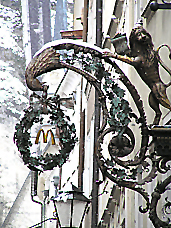 When we passed one ornate sign with a stylish “M”, we each wondered what that could be, until Horst jokingly told us that it was the “American Embassy”, which was actually a “McDonalds”, which drew a few chuckles from the passersby who happened to overhear him.
When we passed one ornate sign with a stylish “M”, we each wondered what that could be, until Horst jokingly told us that it was the “American Embassy”, which was actually a “McDonalds”, which drew a few chuckles from the passersby who happened to overhear him.
Salzburg was once the home of Wolfgang Amadeus Mozart, (January 27, 1756 – December 1791) and everywhere you look you will find Mozart references, from Mozart Square, a sign marking Mozart’s birthplace, Mozart’s Residence, Mozart Sound and Film Collection, to the many shops which have life-size wooden poster cutouts of Mozart holding a box of Mozart chocolates outside their shops. According to Horst though, the posters flatter Mozart since he was not quite as handsome or as tall as the posters make him out to be. Talk about artistic license!
In the summer months, there are outdoor concerts featuring works by Mozart, of course, and during the winter you can enjoy experiencing the city by horse-drawn carriages through the snowy streets.
After our tour ended, Dr. and Mrs. Spengler, and Edward and I desperately needed to warm up, and on Horst’s advice, we stopped to have lunch at Gastwirtschaft, Zum Wilden Mann, located at Getreidegasse 20. The restaurant offered typical hearty Austrian fare, including venison stew and dumplings, which was perfect for such a cold and snowy day.
After lunch, we parted company with the Spenglers, and made our way back to the train station stopping on occasion to visit the many shops offering everything from traditional clothing to the latest fashions. Although the weather gave no indication that spring would be arriving anytime too soon, the shops and kiosks offered their promise of spring with their Easter decorations, as well as primroses and pussy willows for sale. We hurried to the train station and then realized that in our short stay in Salzburg, that we had forgotten to sample the famous Salzburg sacher torte, the decadently rich dark chocolate and ganache Austrian cake! Alas, we had run out of time on this trip, but look forward to sampling the sacher torte on a future visit. We returned to Munich with shoes that were completely wet, but with wonderful memories of our short time in Salzburg. In the morning, after another lavish breakfast at the hotel, Mr. Moser once again drove us to the airport for our next destination, Berlin, Germany.
Although the weather gave no indication that spring would be arriving anytime too soon, the shops and kiosks offered their promise of spring with their Easter decorations, as well as primroses and pussy willows for sale. We hurried to the train station and then realized that in our short stay in Salzburg, that we had forgotten to sample the famous Salzburg sacher torte, the decadently rich dark chocolate and ganache Austrian cake! Alas, we had run out of time on this trip, but look forward to sampling the sacher torte on a future visit. We returned to Munich with shoes that were completely wet, but with wonderful memories of our short time in Salzburg. In the morning, after another lavish breakfast at the hotel, Mr. Moser once again drove us to the airport for our next destination, Berlin, Germany.
For information on Salzburg, please visit: Salzburg Tourism Office.
You may also enjoy reading our other articles on Germany in our Destinations, Hotels & Resorts, Restaurants, Awards, Music Scene, Chefs' Recipes and Gastronomy sections, as well as our previous article on Berlin, Destinations – Berlin 2004 and Mondays in Berlin.
© June 2005. Luxury Experience. www.luxuryexperience.com All rights reserved.

